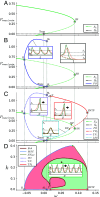How spatiotemporal dynamics can enhance ecosystem resilience
- PMID: 40080641
- PMCID: PMC11929404
- DOI: 10.1073/pnas.2412522122
How spatiotemporal dynamics can enhance ecosystem resilience
Erratum in
-
Correction to Supporting Information for Moreno-Spiegelberg et al., How spatiotemporal dynamics can enhance ecosystem resilience.Proc Natl Acad Sci U S A. 2025 Apr 22;122(16):e2506282122. doi: 10.1073/pnas.2506282122. Epub 2025 Apr 11. Proc Natl Acad Sci U S A. 2025. PMID: 40215285 Free PMC article. No abstract available.
Abstract
We study how self-organization in systems showing complex spatiotemporal dynamics can increase ecosystem resilience. We consider a general simple model that includes positive feedback as well as negative feedback mediated by an inhibitor. We apply this model to Posidonia oceanica meadows, where positive and negative feedbacks are well documented, and there is empirical evidence of the role of sulfide accumulation, toxic for the plant, in driving complex spatiotemporal dynamics. We describe a progressive transition from homogeneous meadows to extinction through dynamical regimes that allow the ecosystem to avoid the typical ecological tipping points of homogeneous vegetation covers. A predictable sequence of distinct dynamical regimes is observed as mortality is continuously increased: turbulent regimes, formation of spirals and wave trains, and isolated traveling pulses or expanding rings, the latter being a harbinger of ecosystem collapse, however far beyond the tipping point of the homogeneous cover. The model used in this paper is general, and the results can be applied to other plant-soil spatially extended systems, regardless of the mechanisms behind negative and positive feedbacks.
Keywords: excitability; plant–soil interactions; resilience; traveling pulses; vegetation patterns.
Conflict of interest statement
Competing interests statement:The authors declare no competing interest.
Figures



References
-
- Lefever R., Lejeune O., On the origin of tiger bush. Bull. Math. Biol. 59, 263–294 (1997).
-
- Rietkerk M., et al. , Evasion of tipping in complex systems through spatial pattern formation. Science 374, eabj0359 (2021). - PubMed
-
- Siero E., et al. , Striped pattern selection by advective reaction-diffusion systems: Resilience of banded vegetation on slopes. Chaos 25, 036411 (2015). - PubMed
Grants and funding
- PID2021-123723OB-C22/Ministerio de Ciencia e Innovación (MCIN)
- CEX2021-001164-M/Ministerio de Ciencia e Innovación (MCIN)
- 101093910/EC | HORIZON EUROPE Framework Programme (Horizon Europe)
- 101071417/EC | European Research Council (ERC)
- OCENW.M20.169/Nederlandse Organisatie voor Wetenschappelijk Onderzoek (NWO)
LinkOut - more resources
Full Text Sources

